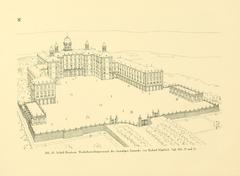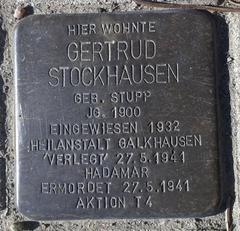
Grube Blücher Visiting Hours, Tickets, and Bergisch Gladbach Historical Sites Guide
Date: 04/07/2025
Introduction: The Heritage of Grube Blücher in Bergisch Gladbach
Grube Blücher stands as a striking testament to the industrial and natural heritage of Bergisch Gladbach, North Rhine-Westphalia. Once a prominent lead and zinc mine within the Bensberger Erzrevier, Grube Blücher shaped the local economy and community from the 19th century until its closure in the mid-20th century. Today, the site captivates visitors with its well-preserved mining relics, interpretive trails, and the inspiring story of ecological renewal on former industrial land.
The mine is emblematic of Germany’s industrialization, reflecting not only technological advancements but also the evolving relationship between industry, environment, and local culture. Its transformation into a protected nature reserve demonstrates the region’s commitment to balancing heritage conservation with ecological restoration, making it a must-visit for history enthusiasts, families, hikers, and nature lovers alike.
For comprehensive visitor resources, official details, and further reading, see Bergisches Land Mining History, BGV Rhein-Berg, and Bergisch Gladbach City.
Table of Contents
- Early Mining Activity in the Bergisch Gladbach Region
- Development and Operations of Grube Blücher
- Grube Cox and Regional Mining Networks
- Industrial Peak and Social Impact
- Decline, Closure, and Legacy
- Heritage Conservation and Natural Renewal
- Practical Visitor Information
- Events, Guided Tours, and Nearby Attractions
- Geology, Ecology, and Conservation
- FAQs
- Plan Your Visit and Stay Connected
- Summary and Key Takeaways
- References and Official Links
Early Mining Activity in the Bergisch Gladbach Region
Bergisch Gladbach’s mining tradition dates back to at least the 16th century. The hilly terrain of Bergisches Land was recognized for its rich deposits of lead, zinc, and iron ore, supporting small-scale medieval operations that evolved with increasing European demand. By the 1800s, the region had established itself as a significant mining district, laying the groundwork for industrial-scale extraction (Bergisches Land Mining History).
Development and Operations of Grube Blücher
Founded in the 19th century, Grube Blücher was named for Prussian field marshal Gebhard Leberecht von Blücher, reflecting the patriotic spirit of the era. The mine’s lead and zinc ores were essential for industrial uses, including ammunition, pipes, and alloys. Technological advancements—such as improved ventilation, drainage, and the introduction of steam-powered machinery—enabled deeper and more efficient mining, making Grube Blücher a linchpin of local industry (Mining Technology in 19th Century Germany).
Grube Cox and Regional Mining Networks
Adjacent to Grube Blücher, Grube Cox exploited similar ore veins, and the proximity of these mines fostered a network of shared paths and tunnels. These interconnected routes, some now restored as hiking trails, facilitated ore transport and shaped the daily rhythms of mining families. Today, they offer visitors a chance to walk in the footsteps of the region’s industrial pioneers (Outdooractive: Grube Blücher & Grube Cox).
Industrial Peak and Social Impact
From the late 19th to early 20th centuries, Grube Blücher reached peak production, employing dozens of workers and extracting thousands of tons of ore annually. The expansion of regional railways enabled efficient transport to Rhineland industrial centers, while ancillary facilities—processing plants, workshops, and miners’ housing—supported a thriving community. Mining shaped not only the landscape but also the social fabric and identity of Bergisch Gladbach (Bergisch Gladbach Mining Heritage).
Decline, Closure, and Legacy
By the mid-20th century, Grube Blücher faced declining ore reserves, competition from cheaper imports, and mounting environmental regulations. Mining ceased in the 1950s, leading to significant economic and social transformation in the region. The closure marked the end of an era but also set the stage for new uses and community renewal (Mining Decline in North Rhine-Westphalia).
Heritage Conservation and Natural Renewal
Recognized for its historical importance, Grube Blücher has since been preserved as an industrial heritage site. Remaining features—shafts, adits, and the iconic Pinge (collapsed mining pit)—are maintained and interpreted through signage and educational programs. The transition from industrial land to nature reserve has encouraged the growth of rare plants and wildlife, offering a vivid example of ecological succession and successful land restoration (Bergisches Land Industrial Heritage).
Practical Visitor Information
Opening Hours:
- The outdoor mining area is open year-round.
- The Naturfreundehaus Hardt (visitor and educational center) operates from 10:00 AM to 6:00 PM, generally on weekends and holidays from April to October.
- Guided tours and museum visits run seasonally; check official sites for current schedules.
Tickets:
- Outdoor trails are free.
- Guided tours and museum entry typically require tickets (€5–€15 depending on tour type and size).
- Book tours online via Bergisch Gladbach City or at the site.
Accessibility:
- Main paths are well-maintained; the Naturfreundehaus is wheelchair accessible.
- Some terrain, especially around spoil heaps and the “Bärenhöhle” tunnel, may be challenging for those with limited mobility.
Getting There:
- By car: Ample parking at Naturfreundehaus Hardt, Hardt 44, 51429 Bergisch Gladbach.
- By public transport: Bus lines 428 or 430, 10-minute walk from the nearest stop.
Facilities:
- Guesthouse/restaurant, restrooms, children’s playground, and educational resources at Naturfreundehaus Hardt.
- Car-free woodland zones and picnic areas.
Events, Guided Tours, and Nearby Attractions
Guided Tours and Educational Programs:
- Led by the Bergisches Museum für Bergbau, Handwerk und Gewerbe, tours last 2–4 hours and focus on mining history and geology (Bergisch Gladbach City).
Special Events:
- Heritage walks, seasonal festivals, and volunteer conservation days foster community engagement and bring history to life (BGV Rhein-Berg).
Nearby Attractions:
- Bensberg Castle, Bergisches Museum, and the Bensberger Schlossweg and Kräuterweg hiking trails (Das Bergische).
- Grube Cox nature reserve and historic Bensberg Altstadt.
Geology, Ecology, and Conservation
Geological Context:
Grube Blücher sits within the Rhenish Massif’s Bensberg ore district, with deposits formed by hydrothermal processes in Devonian limestone. Key minerals include cerussite, anglesite, smithsonite, and hemimorphite, offering insights into supergene mineralization (Geological Survey NRW), (Mindat: Grube Blücher).
Ecological Highlights:
- Spoil heaps and calcareous soils support rare orchids (e.g., bee orchid, pyramidal orchid) and pioneer trees.
- Butterflies, birds (Eurasian blackcap), and mammals thrive in the mosaic of woodland and open ground.
- Ponds and wetlands created by old mining activity provide habitats for amphibians (NABU NRW), (LANUV NRW).
Conservation Status:
Protected as a nature reserve, the area is managed for biodiversity, accessibility, and ecotourism. Visitors are encouraged to stay on marked trails and respect wildlife (Bergisch Gladbach Nature Reserves).
FAQs
Q: What are the opening hours for Grube Blücher?
A: Outdoor areas are open year-round; the Naturfreundehaus Hardt is generally open 10:00 AM–6:00 PM, weekends and holidays (April–October).
Q: Is there an entry fee?
A: Entry to trails and outdoor areas is free; guided tours and museum visits require tickets.
Q: Are guided tours available?
A: Yes, guided tours are available seasonally. Book online or at the visitor center.
Q: Is the site accessible for people with disabilities?
A: Main visitor facilities are accessible; some outdoor areas may be uneven.
Q: Can I collect minerals?
A: No, collecting minerals is prohibited to protect the site.
Q: Are pets allowed?
A: Pets are allowed on leashes but should not disturb wildlife.
Plan Your Visit and Stay Connected
-
Contact:
- Naturfreundehaus Hardt: Hardt 44, 51429 Bergisch Gladbach, Tel: +49 2204 843000
- Bergisches Museum: Burggraben 19, 51429 Bergisch Gladbach, Tel: +49 2202 141555
-
Online Resources:
-
Visitor Tips:
- Spring and autumn offer ideal conditions for hiking and wildlife observation.
- Wear sturdy footwear; trails may be muddy after rain.
- Bring binoculars and field guides for nature spotting.
- Respect all conservation rules and stay on marked paths.
-
Enhance Your Experience:
- Download the Audiala app for interactive audio tours and real-time updates.
- Explore virtual tours, trail maps, and event calendars via the official websites.
Summary and Key Takeaways
Grube Blücher is a vivid symbol of Bergisch Gladbach’s industrial, ecological, and cultural evolution. From its roots as a vital mining hub driving the 19th-century economy, through its closure and natural rebirth, it remains a living monument to resilience and renewal. Visitors today can explore accessible trails, engage with hands-on educational programs, participate in community events, and enjoy the rich biodiversity of a landscape transformed by both industry and nature.
With a variety of amenities, well-marked trails, and strong community stewardship, Grube Blücher is an ideal destination for all ages and interests. Plan ahead with current information on hours, tickets, and events, and make the most of your visit by tapping into official resources and guided experiences.
References and Official Links
- Bergisches Land Mining History
- Mining Technology in 19th Century Germany
- Bergisch Gladbach Mining Heritage
- Mining Decline in North Rhine-Westphalia
- Outdooractive: Grube Blücher & Grube Cox
- Das Bergische: Glück auf in der Grube Blücher
- BGV Rhein-Berg: Denkmal Grube Blücher
- Bergisch Gladbach City: Führungen und Exkursionen
- Kuladig: Naturfreundehaus Hardt and Mining Relics
- Komoot: Grube Blücher Hiking Highlight
- NABU NRW: Nature Conservation in Bergisches Land
- Geological Survey NRW
- Mindat: Grube Blücher Mineralogy
- LANUV NRW: Environmental Monitoring


